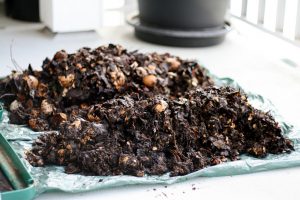 Composting is one-half creating the pile (or bin) and setting everything up, and one-half putting the right things into it to create fresh, nutrient-rich soil for your garden. There are some things that cannot be added at all, as they will disturb the mix, but plenty of vegetable scraps can go in. You also need to keep the right balance in order to prevent your compost pile from going rancid or not decomposing as well. Here are some basic tips:
Composting is one-half creating the pile (or bin) and setting everything up, and one-half putting the right things into it to create fresh, nutrient-rich soil for your garden. There are some things that cannot be added at all, as they will disturb the mix, but plenty of vegetable scraps can go in. You also need to keep the right balance in order to prevent your compost pile from going rancid or not decomposing as well. Here are some basic tips:
What Can Go In
Many things can be added to your compost pile. Scrap bits of vegetables and fruits, grass clippings, chicken manure (just not any parts of the chickens themselves), egg shells, coffee grounds, loose tea, bits of plants that have been pruned (flowers, shrubs, and so on), straw, wood ash, newspaper, cardboard, dryer lint, pine needles, wood chips… just about anything that is all-natural, or once was all natural, can be added. As you can see, compost piles are a great way of reducing your carbon footprint, as they save many things from going into landfills.
What Cannot
Certain things absolutely can’t be added to your compost pile. These include both red meats (beef) and white meats (poultry, pork), fish, and bones of any kind. You also shouldn’t add weeds, any diseased plants, or pet wastes to your pile.
Browns versus Greens – Keeping the Right Balance
The trick to having a successful compost pile lies in the balance between brown things and green ones. Browns tend to come from trees, so pine needles, newspaper, leaves, and so on count, as well as hay and straw. Greens include anything fresh and growing, so flowers, grass clippings, and fruit and vegetable scraps count here. Basically, anything that is rich in nitrogen is a “green,” while anything containing carbon is a “brown.” The ratio that you need to keep your compost pile from stinking (which is a sign that something has gone wrong – it should smell a little, but not reek) is two thirds “browns” to one third “greens.”
Keeping Weeds from Growing
At times, weeds and other plant life may begin to grow around the edges of your compost pile. This is usually a problem with the soil-based types of open air piles, not the ones that exist in plastic bins, simply because the latter types are inaccessible by these green and growing pests. Plants in general will be attracted to the nutrient-rich mixture in the compost pile. Thankfully, the center of the pile is usually too hot for anything to grow properly, so the issue is relegated to the edges, where they can be easily removed by hand or with a small trowel. As long as you keep an eye on your compost pile, this won’t be much of a problem.
After your compost pile set up and loaded with the right ratio of carbon and nitrogen based things, you’ll need to do a little maintenance. Make sure to turn it at least once a week, and include some water with each new layer that is added. You can also toss in a few shovelfuls of soil from your garden for good measure.
Pic by Lindsay




No comments yet.